Matador Network's Blog, page 935
January 24, 2020
Grand Wailea's stained glass windows

The year 1965 proved tumultuous for the people of Indonesia. Massive power shifts were taking place in the country, and Indonesia’s leader, known as Sukarno, found himself the subject of a military coup. Anti-communist sentiment lead to a genocide of around 800,000 people, including some ethincally Chinese people as well as communists. Sukarno landed in house arrest (where he would die in 1970). It’s perhaps no wonder that Yvonne Cheng, an artist who would eventually become known for paintings of Hawaiian women, and whose grandmother was Chinese, no longer felt safe in her home country. Her then-husband David, who built high-rise hotels in Jakarta, was a friend of Sukarno’s. The couple was in serious danger.
“‘We left’ is a nice way to put it,” Cheng tells me from her home on Oahu. “We had to leave quickly.”
She and her husband decided to flee Jakarta, settling in Cambridge, Massachusetts. David knew the area; he had attended Harvard. What Cheng didn’t know is that this terrifying journey away from home and to safer harbors in the United States would launch her career as an artist.
As soon as the couple made it safely to Cambridge however, David began to pine for the pristine shores of Honolulu. He’d been introduced to Hawaii by Sukarno himself. In fact, the pair often vacationed together (“Sukarno had girlfriends everywhere,” Cheng quips). In 1967, the family decided to move to Honolulu, the city she would end up making her home for the rest of her life.
Once Cheng settled in Honolulu she set about caring for her two stepchildren. But back in Indonesia, she’d had a housekeeper and cook help run her home. Cheng had no idea how to be a housewife, and soon found herself listless and bored. At the suggestion of a friend, she took up Chinese cooking classes at the YMCA.
“It was in an old building and then they had art classes too,” recalls Cheng. “I knew how to draw, but I wanted to do something more than that.”
Cheng had taken art classes at the the Dutch-run highschool she attended in Jakarta, where “they taught you until it almost killed you.” She had the classical technique behind drawing figures drilled into her mind. But she wanted to learn to be more creative, to develop her own style.
Cheng started off by drawing Indonesian figures, but felt compelled to draw more of what she saw around her. Cheng visited Honolulu’s Bishop Museum, and learned everything she could about Hawaiian history. The museum offered art classes of its own, and she signed up. Then one day, Cheng attended a luau. She was mesmerized by the dancers.
“They were so graceful. I really fell in love with it,” she says.
Cheng decided to devote her career as an artist to drawing figures of Hawaiian women — draped in patterned fabrics and reclining in front of giant banana leaves. Cheng paid special attention to the textiles, a medium she’s been fascinated with since seeing her grandmother don intricately designed sarongs and Indonesian batiks. As a stay-at-home mom, she had the opportunity to pursue painting full time, and she took it.

Photo: Scott Hughes
Around the time she began her Hawaiian figures, a hotel developer named Takeshi Sekiguchi introduced himself to her. The pair enjoyed the same social circle, and Sekiguchi, an art collector, heard that Cheng had begun painting Hawaiian women. He had a new property in the works — the hotel that would eventually become the Grand Wailea — and he wanted it to have an authentic Hawaiian atmosphere. Sekiguchi hoped she could help provide some of the artwork that would decorate it, and immediately commissioned artwork from her. But Cheng wasn’t entirely convinced she could pull it off.
“I was just an upcoming artist,” Cheng says. “It was very exciting for me. It was kind of scary. I wasn’t sure if I wanted to do it. The scope of it scared the living daylights out of me.” She and Sekiguchi talked over her concerns, and he ultimately convinced her to take the job. “I thought, well, if everyone thinks I can do it, I might as well do it.”

Photo: Grand Wailea
Sekiguchi wanted Cheng to focus especially on creating stained-glass windows for the wedding chapel he planned to build on the grounds of his new hotel, as well as mosaics for interior. He left the design up to her. She landed on simple, but powerful, depictions of Hawaiian people in nature: Each window features Hawaiian women, draped in white-and-cream-colored robes, and crowned with bands of red fabric. The murals depict Hawaii’s verdant landscape, too, like a river running through green hills. In one panel, three women gather water by the river; in another, a warrior watches over a procession of women walking on a hillside. She also created a mosaic mural for the foyer that leads to the hotel’s massive dining room which depicts three women clad in robes, surrounded by voluminous banana leaves.

Photo: Grand Wailea
As a painter, Cheng had never worked with either medium (mosaic or stained glass). Sekiguchi wasn’t worried. Instead, he flew her out to Italy to meet with Bisazza, the Italian mosaic company. She met with the son of the company’s owner, and the pair went over her watercolor mockups of the design.
“They let me stay in a hotel overlooking the canals,” Cheng recalls. “And then they drove me toward Eastern Europe, where they had the mosaic factory, so I could see them make it.”
In 1991, 29 years ago, the Grand Wailea opened, complete with the chapel, situated on a pond overlooking the beach, surrounded by palm trees, baring Cheng’s designs, as well as the expansive mosaic adjacent to the dining room. The chapel quickly became a wedding hotspot: Couples gravitated toward the stunning, almost-psychedelic stained-glass windows, which are the centerpiece of the structure. The tiny chapel is intimate, the epitome of romance, and yet its location at the resort lends an air of glamor and sophistication.

Photo: Grand Wailea
Over the years, couples began gravitating toward the beach for their weddings and the chapel sadly fell out favor. Yet when I visited in 2018, guests of the resort could be seen wandering in and out of its open doors, drawn again to Cheng’s spectacular windows which catch the sunlight and seem to glow. Inside the solitude of the chapel, the buzzy, energetic atmosphere of the resort falls away and a feeling of serene calm takes over. Cheng’s work casts a spell. In a place that can seem to cater solely to the whims of tourists, her work elevates the people and the natural beauty of Hawaii.
Today, Cheng is still painting her signature figures for art shows around Hawaii with other women artists, and people are still buying her work. She’s also taken up ink and brush designs, and still dabbles in textile design. Her stained-glass windows, however, remain timeless — and still evoke powerful memories for the artist herself.
“You know when you’re younger you just think ‘Yeah, I can do it.’ But you don’t think further,” she says. “You don’t think of all the things that could go wrong. But I had a lot of help and people that encouraged me. I’m amazed that I did it.” 

More like this: Why Oahu should always be your first Hawaii vacation
The post The artist behind the stunning stained-glass art at one of Maui’s most famous hotels appeared first on Matador Network.

Aboriginal sites damaged by fires

As if the Australian bushfires haven’t already led to enough devastation, now archaeologists are afraid that thousands of historic Aboriginal sites and artifacts may have been damaged by the fires. Much of the area destroyed by the fires was home to important indigenous sites, which served as living monuments to how people lived thousands of years ago. The sites have also proven invaluable to the scientific understanding of rock art, canoe carving, and other Aboriginal practices.
Georgia Roberts, an archaeologist in Bacchus Marsh, Victoria, told Nature, “It’s not a question of if significant sites have been impacted, it’s just a matter of determining the extent and how badly they’ve been impacted.” Although a formal assessment of the damage has not been done, experts are calling on the government to launch a thorough investigation of important sites to gauge the fire’s effect on historically significant sites and artifacts.
The one upside to the situation, however, is that the fires may have cleared away areas of dense vegetation that were previously inaccessible. Some of these places could potentially hold culturally important sites. The fires in the Budj Bim Cultural Landscape, for example, revealed previously unknown sections of the channels and pools carved into the rock by indigenous peoples 6,000 years ago. 

More like this: How you can help the people and animals affected by the fires in Australia
The post Australian bushfires may have damaged thousands of Aboriginal sites appeared first on Matador Network.

January 23, 2020
Ultimate guide to uphill skiing

If you’ve visited a ski resort in the last few years, you may have noticed signs stating “uphill access point” near the base. While riding the chair to your favorite runs, you might also have casually looked down at the skiers on the run below and noticed a few going against the grain — sliding, one foot in front of the other, up the hill — not schussing down it.
They’re actually doing this of their own volition, partaking in an activity called “skinning.” Those vested in the sport call it exercise. Many observing it for the first time call it “crazy.” But as ludicrous as this all may look as you soar overhead, the practice appears to be here to stay. Here’s the lowdown on skinning and how you can join in on the madness.
What is skinning?

Photo: Catalin Grigoriu/Shutterstock
Skinning allows skiers, or snowboarders on “splitboard,” to better grip the snow when they are moving their skis or the two halves of their splitboard up a slope — by applying a grippy strip onto the bottom of their skis. The strip has an adhesive surface on the side in contact with the skis and a fuzzy surface on the snow-facing side. The adhesive is designed to grip firmly to a ski’s waxed underside but be removable when it’s time to actually descend by skiing.
“Skins” get their name from the seal hides that were attached to the bottom of skis back in the 1930s in order to prevent backward sliding. The hides have been replaced in modern times by nylon or mohair, made from Angora goats, or a combination of both materials.
Skinning was born in the backcountry, allowing skiers to move uphill on mountain trails to enjoy untracked powder. Yet it has now made its way in-bounds at many resorts despite the existence of alternative ways to get up the mountain — like chairlifts or gondolas — and often without the presence of untracked powder to serve as a reward for all the effort.
Ski resorts react to the practice.

Photo: anatoliy_gleb/Shutterstock
With skinning’s surging popularity, ski resorts across North America have adopted formal policies around it. Powderhorn Mountain Resort in Colorado has a dedicated skinning page on its website, which includes a map of permitted uphill routes. The resort, like many, requires uphill users to check-in at the base area and obtain a free “uphill use ticket” prior to setting out. It also disavows any responsibility for injury, stating, “The ski area welcomes and supports individuals seeking to exercise and enjoy the quiet mountain setting. However, all uphill travel is done at the individual’s own risk.”
Many resorts require uphillers to be on the mountain before the lifts open, often requiring skiers to set a pre-dawn alarm in order to get through their suffer-fest before the regular Joes begin loading at the base. New York’s Hunter Mountain Resort, for example, states that the resort “allows uphill access via skinning and snowshoeing during the winter operating season only two hours prior to operating hours.”
Other resorts are more cautious about permitting uphill access, and some consider the activity against their policy. If you plan to give skinning a try, check the website of the resort where you plan to go to make sure you’re aware of their rules.
In general, these diehards follow specified routes up the hill, often in what’s known as a “skin track” cut by previous masochists on the same route. Skinning is all about having a tranquil experience. The sun piercing through the crisp morning air as it rises over the peak ahead, the only noise being the “whoosh” of poles dipped in fresh powder and an occasional moose trotting by. It’s a skiers’ version of meditation, a way to truly connect with nature and slow down the pace of the sport they love. And because they’re moving so slowly up the mountain, they’re sure to be recognized — and rightfully congratulated for their unparalleled devotion — once they finally make it back down to the base lodge.
Not to mention the health benefits of all that cardio.
Save that lift ticket money for beer.

Photo: GROGL/Shutterstock
Skinning is a great exercise, for sure, but the real perk of the increasingly tolerant policies is that they generally allow for uphill access without buying a lift ticket. The retort to this could fall along the lines of, “Why are these crazy assholes allowed to ski the mountain for free while I have to buy a lift ticket?”
The answer lies in the question itself: The piece of paper or plastic you have secured to your jacket is a lift ticket. Because most ski areas operate terrain on leased federal land, those runs you’re skiing on are technically public property. The ticket gives you access to the lifts to ride to the top, saving the nightmare of hauling yourself up a mountain on foot, but in many cases doesn’t actually entitle you to any additional perks as far as trail access is concerned. Policies vary by resort, but in essence, what you’re paying for is convenience, as well as time since the time it takes to get uphill is time you aren’t actually skiing it.
Are these lunatics really that frugal?

Photo: michelangeloop/Shutterstock
If you’ve ever lived in a mountain town, you’re likely aware of the tight budget constraining the lifestyle of the local ski bum. That liftie job might offer a free season pass, but the pay is less than sexy, and the hours spent standing outside on freezing winter days can be brutal. Likewise for much of the town’s hospitality sector, and they may not even be entitled to the free season pass.
It would make sense, then, that skinning up the mountain could make for a solid way to enjoy the slopes while keeping some dough in his pocket. Why would you spend $100 on a lift ticket when that money could go so far at the bar in the lodge?
There are also plenty of people attracted to uphill skiing for other non-financial reasons. Some people who could afford a lift ticket opt to spend the day skinning uphill because they want to “earn their turns.” Uphill skiing is another hardcore pursuit for the same folks who in warmer months would be jumping on their Pelaton, dashing off to Soul Cycle, or spending their day at their local CrossFit.
This excellent exercise also gives you the rejuvenating feeling of being outdoors — without having to use a mechanized, energy-consuming chairlift and without the avalanche risk of off-piste or backcountry skiing.
A checklist for uphill ski nuts

Photo: michelangeloop/Shutterstock
General best practices for uphill skiing within resort boundaries include making sure you are visible to those above you. Don’t stop at the bottom of a roller or make wide cuts across the center of runs when skiers are coming down. When possible, begin your ascent prior to the time that lifts open. Also, you’re still subject to the same terrain closures as everyone else. Just because you earned your turns doesn’t give you permission to duck ropes.
As long as you agree to these rules, and are okay with the possibility of being laughed at, here’s what you need to get started.
A pair of skins for your skis or board. These are available at your local ski shop and will run you between $100 and $200. The shop can help you cut the skins to fit your skis.
If you’re a snowboarder, you’re going to need a splitboard — a snowboard that splits in half to become two skis and then snaps back together when it’s time to drop in. Jones Snowboards, founded by big-mountain legend Jeremy Jones, is a leader in splitboard innovation and a great place to start. Plan to spend between $500-$1,000 or shop around for a used board to save some dough.
Snowboarders also need splitboard-specific bindings, of which Spark R&D is the go-to producer. You’re looking at another $200-$500 here, but again, you can opt for used gear.
Skiers need loose-heel bindings or tele-bindings. A new pair will run you $200-$500. Beginners can opt for the affordable but dependable Marker Griffin 13 ID.
You’ll want a winter-specific touring backpack such as the Spindrift 32 L from Mammut.
General backcountry gear — including a beacon, shovel, and probe — is recommended, as well, and mandatory should you step into the backcountry. Ortovox specializes in this gear.


More like this: These US hikes are actually better in cold weather
The post Uphill skiing is booming at winter resorts, and yes, these people are nuts appeared first on Matador Network.

Things to do in eastern Turkey

Beautiful coastlines, fascinating archaeological sites, and a vibrant blend of cultures make Turkey, a country straddling Europe and Asia, one of the world’s most unique destinations. However, nearly all of its best-known tourist sites — Istanbul, the Ephesus ruins, Mediterranean seaside towns — lie in the country’s west. In comparison, Turkey’s eastern half remains a mystery to most international travelers.
Eastern Turkey, stretching far beyond central Cappadocia, has had a tumultuous past, but it’s also an underappreciated part of the world that adds to the country’s diverse cultural landscape. Here’s why you should venture beyond Cappadocia to Turkey’s underexplored eastern region.
It’s Turkey without the crowds.

Photo: osonmez2/Shutterstock
The country had almost 40 million visitors in 2018, a dramatic increase of over 20 percent from the previous year. If you’ve been in the crowded lanes of Istanbul’s Grand Bazaar or in a hot air balloon above Cappadocia at sunrise, you’ve seen where the majority of those visitors spend their time. The top places that these tourists visit are concentrated in the country’s western half, and this is the charm of exploring Turkey’s east.
You’ll see far fewer visitors on the Black Sea Coast and the regions of south and eastern Anatolia, as the Asian side of Turkey is called. Because of this, hostels and tourist-centric restaurants aren’t nearly as common. On the dining front, this makes finding a good kebab meal for about 15 Turkish lira, about $2.50, an easy thing to do. On the other hand, while there are some hostels, their lack of ubiquity means you might find yourself buying hotel rooms, for which a standard night will run you between $30 and $50. If budget accommodation is your goal, book in advance and build your trip around where you’re able to secure hostel lodging.
It’s home to some of the country’s most important historical sites.

Photo: canyalcin/Shutterstock
With the well-preserved ruins of Ephesus and the Blue Mosque of Istanbul often stealing the limelight, most people wouldn’t be able to recognize any of eastern Turkey’s attractions. The region’s most popular, and downright jaw-dropping, attraction is Mount Nemrut, the spectacular tomb of King Antiochus I, which dates back to the first century BC.
Situated at a lofty 7,000 feet, the site has a number of large stone statues of important Gods from the Commagene Empire — these statues face outward from both the summit’s eastern and western sides. The figures have crumbled with time, and the now-severed heads of the statues lie on the ground at their feet, but the remarkable sight remains a non-negotiable addition to any itinerary of Turkey’s east. Watching the sun set or rise from this archaeological site is one of the most memorable experiences you’ll have on a trip here.
Not far from Nemrut are pilgrimage point Abraham’s Cave and the Pools of the Holy Carfa in the town of Sanliurfa (often shortened to Urfa). Located in southeastern Anatolia, this is where the biblical prophet Abraham is believed to have been born, near the city formerly known as Edessa, which played a major role in the Second Crusade. You can venture inside the cave, with guided tours available to handle transportation and planning if you wish.
Another site to visit is Gobekli Tepe northeast of Urfa, a small archaeological site that is considered by many to be the oldest temple ever recovered. The ancient temple ruins consist of a series of pillars, around which visitors can see the layout of what were the several rooms of the temple. The site received UNESCO World Heritage status in 2018.
It’s packed with photogenic old towns.

Photo: Nejdet Duzen/Shutterstock
Aside from sights for history buffs, you can also find some of Turkey’s prettiest towns in the eastern region. In particular, Southeastern Anatolia’s plains are dappled with picturesque settlements built from sand-hued bricks, with both old mosque minarets and church bell towers piercing the skyline. With a much lower population density than the west, the dry plains of Mesopotamia stretch for much of the southeastern area.
Mardin, not too far from the Syrian border, is perhaps the best known of these towns. It’s twisting alleyways, intricately carved mosques, and location that cascades down a hill overlooking Mesopotamia makes it among the most photogenic spots in the country. It’s also a unique cultural experience, with Kurdish, Yezidi, and Syrian traditions coexisting amongst the mosques, temples, and churches. Although you won’t find many foreign visitors, it’s one of the busier places in eastern Turkey as it’s a popular weekend spot for domestic tourists. However, the nearby towns of Midyat and Savur have similar honey-colored and maze-like old streets that you can wander through almost completely on your own.
The landscape is rugged — but inviting.
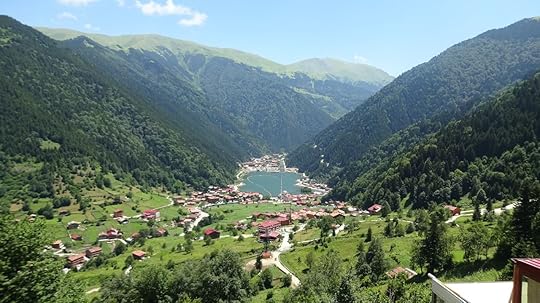
Photo: AMMOMI/Shutterstock
The landscape and climate of eastern Turkey changes quite dramatically from south to north, with the southeastern Anatolia plains being dry and hot and merging into dense forest and rolling hills up near the Black Sea. It’s a part of the world that dramatically changes as you move through it — in terms of culture, tradition, and landscape — and it’s this diversity that makes it such a fascinating place to explore.
If you’re after something green and vibrant, Uzungol is one of the Black Sea region’s most attractive towns, situated around the edge of its namesake lake in the northern part of Turkey. Its misty, forested hills beg comparisons to Switzerland, which has caused the town to see rapid development as tourists have begun to roll in. The nearby mountain ranges offer excellent hiking. The 1.2-mile trail around the lake is a solid introduction to the area, and for a challenge, hit the six-plus-mile Yaylaönü trail, which begins at the lake and extends into the high country.
It’s possible to climb Mount Ararat, the dormant volcano that holds religious and mythical significance for Armenians and which sits in the far east of Turkey. It’s not a simple expedition, however, with its peak reaching the height of 16,800 feet that requires five days of hiking and four nights of high-altitude camping. Other outdoor activities like hiking are possible further north in the Black Sea region, with Haldizen and Soganli Mountains being the most popular spots for hitting the trails.
It’s home to a complex blend of cultures.
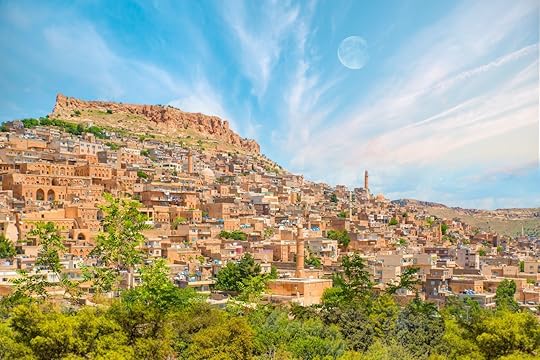
Photo: muratart/Shutterstock
Eastern Turkey has been home to frequent troubles over the years from political protests, including the 2013 Gezi Park uprising that spread east from Istanbul and drew global headlines as citizens united against unwanted development. Turkey’s eastern region has also seen tense relations with its neighbors and prolonged armed conflict with the large Kurdish population in eastern Turkey. Although this prevented tourists from visiting for many decades, foreigners have been allowed to explore the region freely since 2000.
Part of what makes eastern Turkey so engaging is its major role in social, historical, and religious movements that have shaped the Middle East and beyond. There are very few places where you can encounter so many different religions, traditions, and remnants from great empires. Christians, Muslims, Armenians, Ottomans, Persians, Kurds, Romans, and many more have called eastern Turkey home, and although this complex mix of cultures and religions has often led to instability, its people are among the world’s most culturally diverse.
From old mosques with intricately carved minarets in Mardin and bell towers of nearly abandoned Orthodox Christian churches in Midyat to the impressive Ottoman-era Ishak Pasha Palace in Dogubayazit, from the atmospheric cultural capital of the Kurds in Diyarbakir to the ancient Armenian churches in the far east, you can virtually trace the history and various cultures of the Middle East across the region. 

More like this: Exploring Turkey’s stunning Mediterranean coastline by boat
The post Beyond Cappadocia, eastern Turkey has few tourists and a lot of culture appeared first on Matador Network.

Best Maldives wildlife experiences

The Maldives may be the hottest luxury destination on the planet, but the chain of 26 atolls and islands peppering the Arabian Sea is also one of the most underrated destinations for ethical wildlife tourism experiences. What’s especially unique to this high-end locale is the way wildlife is incorporated into how tourism operates here. There are dedicated excursions and experiences for seeing wildlife, but animals also show up in the most elevated of experiences, such as dining in an underwater restaurant or getting a massage above a floor window with underwater views.
Whether you’re happy to have incidental wildlife experiences while relaxing on an above-water cabana or travel purposely to see the abundant animal life of this part of the world, these nine experiences will take you straight to the action in the wilderness of the Maldives.
1. Sailing among mega pods of dolphins
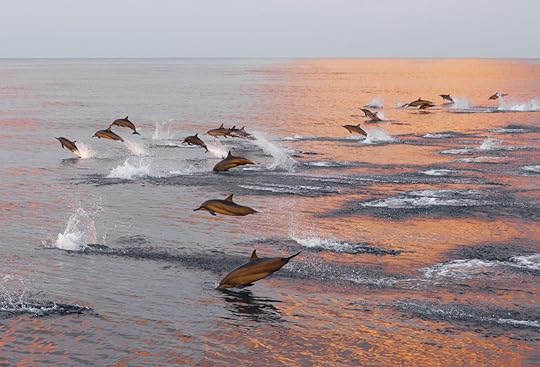
Photo: lena2016/Shutterstock
As night falls at the Mercure Maldives Kooddoo Resort, local dolphins begin their “commute” home through a channel adjacent to the resort. A dedicated boat excursion brings guests to see this nightly phenomenon in which thousands of dolphins playfully make their way through the water, jumping high into the air at a seemingly non-stop pace. If that wasn’t captivating enough, the same channel is used by beautiful fruit bats making their way between nearby islands, putting you right between one of the most unique naturally occurring wildlife experiences on the planet.
Pro-tip: The boat tends to leave a few minutes before schedule, especially if the dolphins have been spotted, so head to the dive dock early.
2. Staying in an underwater hotel room

Photo: Conrad Maldives Rangali Island/Justin Nicholas/Facebook
This is one of the best examples of the Maldives’ special circumstantial wildlife experiences. The underwater rooms of The Conrad Maldives on Rangali Island are a wonderful way to observe wildlife without interfering. It would be easy to say it’s like sleeping in an aquarium, but in reality, you’re the one in a glass room while the sea creatures watch, wild and free. As another option, the recently opened Pullman Maldives has an aqua villa giving that same under-the-sea perspective, though expect to see even more resorts adding this popular feature to their accommodation offerings.
3. Night snorkeling with whale sharks

Photo: Dudarev Mikhail/Shutterstock
From November to April, the sea’s largest fish comes to the Maldives to enjoy the warm water. Guests of Como Maalifushi have the opportunity to see these whale sharks up close during the hotel’s night-time snorkel excursion, a rare experience that brings people into the vicinity of one of the most interesting animals on the planet. Whether you jump in the water or hang out on the boat’s deck, this is a night you’ll never forget.
4. Taking a scuba-diving cruise

Photo: Rich Carey/Shutterstock
Divers know the clear, warm waters of the Maldives are unlike anywhere else. The Four Seasons has leaned into this feature by creating a floating liveaboard hotel for their diving guests. The three-story catamaran sails from the garden island of Kuda Huraa to the pristine hideaway of Landaa Giraavaru with no more than 22 other guests onboard at a time. Cruises are offered as three, four, and seven-night experiences.
5. Dining outdoors among wild flying foxes
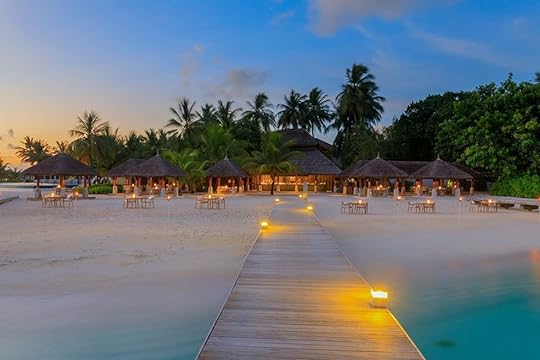
Photo: VELASSARU MALDIVES/Facebook
Flying foxes live throughout the Maldives, giving the islands a truly magical feel as they flit between tropical palms searching for fruit snacks. Maximize your time witnessing these flying critters by dining beneath them, and the stars, at Velassaru Resort’s oceanfront dining, or the Mercure Maldives Kooddoo Resort’s new custom outdoor dinner, which romantically arranges guests in a private garden area.
6. Daytime snorkeling on the reef to see sea turtles
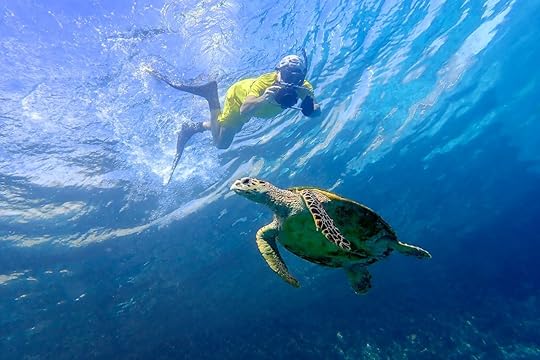
Photo: Miroslav Halama/Shutterstock
While diving in the Maldives is a truly unforgettable experience, going deep isn’t necessary to appreciate the wildlife here. The Heritance Aarah has a special spot within its atoll where sea turtles reliably gather, and the guides here are great at ensuring you have the best chance possible of spotting them. And even if sea turtles don’t enter the picture, there’s lots of other beautiful marine wildlife to spot on this remote reef.
7. Dining underwater at the Conrad Maldives Rangali Island

Photo: Conrad Maldives Resort /Facebook
Even if you can’t snatch one of the underwater rooms at The Conrad, you can still enjoy underwater life by dining at the restaurant. The food is incredible, but it can be hard to focus when wild and free ocean species peer in at you from above (and from the sides). It’s another one of those only-in-the-Maldives experiences where luxury meets ethical wildlife viewing, and even those who may not consider themselves animal lovers will be mesmerized by the incredible life surrounding them.
8. Onshore reptiles, crabs, birds, and more
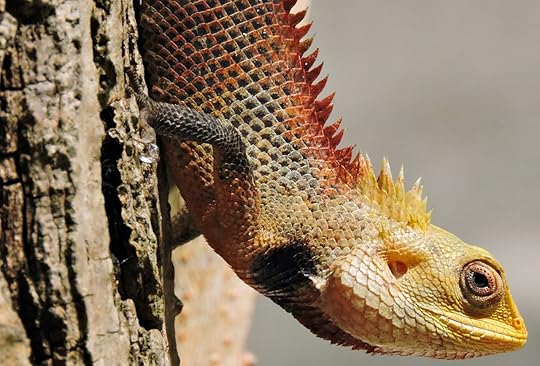
Photo: TPROduction/Shutterstock
Wildlife lovers will want to keep an eye out for the small life forms that call the Maldives home. Lizards, hermit crabs, mangrove crabs, ghost crabs, geckos: There’s no shortage of local species darting between the bushes and captivating those who are keen wildlife observers. The land-based animal life, from tiny geckos to soaring seabirds, enjoys the luxury of the Maldives as much as any visitor, but the best way to see them is by picking a residence onshore as opposed to above the water.
9. Enjoying the sea’s wildlife while getting a spa treatment
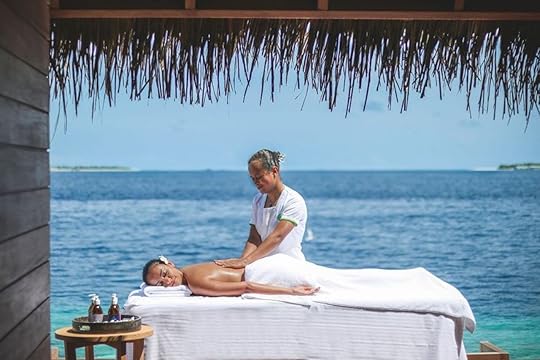
Photo: Heritance Aarah/Facebook
The Heritance Aarah is not only home to the only Medi Spa (a hybrid between a medical clinic and a spa for the purpose of relaxation and rejuvenation) in the Maldives, but it also offers incredible viewing access to undersea life during spa treatments. As you lie down for a relaxing massage, peer through the windows installed into the floor for an extra dose of relaxation: There’s something soothing about seeing fish, sharks, and whatever else feels like swimming by while a trained masseuse eases the tension from your back. 

More like this: Where to swim with the world’s most amazing marine wildlife
The post The best Maldives experiences that combine luxury and wildlife appeared first on Matador Network.

History of poke and poke bowls

I heard music playing in the main courtyard from my room at the Koloa Landing Resort at Poipu, Kauai, at around 9:30 in the morning. As I walked past pools and the Holoholo Grill to get there, I heard an emcee with a microphone before I saw him.
“We’ve got a lot of great things coming up for you all with the first-ever poke fest on Kauai,” the emcee said. “Why? Because Sam Choy said so!”
If you’re talking about poke in Kauai, the name Sam Choy is guaranteed to come up. Choy — a James Beard Foundation’s America’s Classics winner, recognized for “food that reflects the character of their communities” — is one of Hawaii’s most famous chefs and a big proponent of poke.
He’s credited with helping make Pacific rim cuisine (think fish with peanut coconut sauce, dishes loaded with dried shrimp, and, of course, poke) a culinary genre in its own right and has been called Hawaii’s culinary ambassador. But above all, and perhaps more than anyone else, Choy is an ambassador for poke. He includes it on menus at his restaurants around the world (including Holoholo, the on-site restaurant at Koloa Landing), promotes it in conversation, and advocates for it on his public profiles. He’s quick to joke and fun to be around, and the fact he’s quick to offer up tastes of true Hawaiian poke doesn’t hurt.
Yet this 2019 Kauai poke festival was the first to celebrate all things poke on the island. Here, all poke means all: both true Hawaiian poke made simply with tuna, sea salt, and seaweed, as well as interpretations brought from mainland chefs. The festival comes at an interesting time for poke. It’s been years since restaurateurs and eaters on the mainland became obsessed with this particular aspect of Hawaiian cuisine, and it’s changed significantly since its beginnings as a fisherman’s snack.
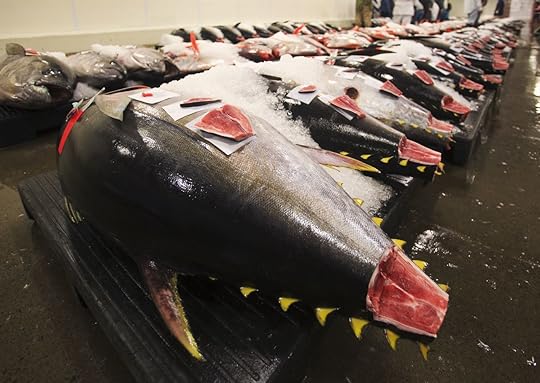
Photo: tomas del amo/Shutterstock
Poke, and fish in general, is big business in Hawaii. According to the Hawaiian state government, 71 million pounds of seafood is available to eat on the islands every year — that’s 134 million meals, or around 36 pounds per person. Around 45 million pounds, or 63 percent, of that seafood comes from local fishing.
Some of the best of Hawaii’s fish can be found at the Honolulu Fish Auction. Here, fresh tuna, swordfish, mahi-mahi, and other types of fish are sold right next to the oceans they were caught in. It’s based on the Tokyo fish market, meaning the prized big catches are sold by the fish rather than by the boatload.
People on the Hawaiian islands have always relied on fish as a dietary staple. One of the traditional methods of fish preparation involved Hawaiian fishermen cutting reef fish into chunks or smashing it up before seasoning with salt, limu (seaweed), and ground nuts from the kukui tree, Rachel Laudan documented in her 1996 book, The Food of Paradise: Exploring Hawaii’s Culinary Heritage. It’s not all that different from how other cultures around the world prepare raw fish: sashimi in Japan, kinilaw in the Philippines, ceviche in Peru, tartare in France, yusheng in China.
The first written recipes for poke appeared in the 1970s, Laudan found in her research on traditional Hawaiian cuisine and language. Poke simply means “to cut into pieces,” and the written recipes gave a name to a long-used style of preparation that wasn’t previously recorded. Giving the dish a name and publishing recipes for it also widened the reach of poke beyond Hawaii’s fishing communities.
“Locals who left for the mainland in the 1960s often have no recollection of poke and when they return to the Islands express surprise to be offered it so frequently,” Laudan wrote. By the 1990s, she was coming across grocery stores with 20 types of poke for sale, including variations based around aku (tuna), ahi, nairagi (striped marlin), tako (octopus), swordfish, ake (raw beef liver), and oio lomi (mashed bonefish).
A major poke turning point came in 1991. That year, Sam Choy hosted the first Poke Festival in Waimea on the island of Hawaii. A luxury resort took over the event in 1994, and by 1999, it was a standing-room-only event. It wasn’t long before chefs and restaurateurs on the mainland started to take notice and approach poke with a “why not here” mindset.
“We’ve absolutely seen an increased interest in poke by tourists from the mainland and Canada,” says Roy Yamaguchi, chef and owner of Roy’s Restaurants and co-chair of the Hawai‘i Food & Wine Festival. “National media exposure featuring Hawai‘i’s culinary scene is evident today in the proliferation of Hawaiian- and poke-themed restaurants on the mainland. Poke restaurants have grown five-fold on the mainland due to Hawaii’s growing reputation as a culinary destination. Tourists now come to the Hawaiian Islands seeking out poke more than ever.”
Hawaiian cuisine spread to places that Hawaiians moved to. Hawaiian migration to the mainland came in waves, as detailed in J Këhaulani Kauanui’s article “Diasporic Deracination and ‘Off-Island’ Hawaiians.” Two of the latest waves were in the 1970s, due to military enlistment and tourism development on the islands, and in the 1990s, due to poor economic conditions and civil rights abuses against native Hawaiians. Poke’s growth in the contiguous United States happened slowly, then all at once. Many people living from the Pacific coast to the Atlantic and everything in between were largely still getting used to eating raw fish in the form of sushi in the 1980s, after all.
These historical forces and the trends of the restaurant world combined in the mid 2010s to create the current poke craze. Fast-casual, build-your-own restaurants were thriving. By 2014, the Chipotle-ization of poke was in full swing. A 2016 Eater story titled “Proof that the Hawaiian dish is here to stay” used Foursquare data to find that, from 2014 to 2016, the number of Hawaiian restaurants (pushed by poke’s popularity) went from 342 to 679. The New York Times started paying attention to mainland poke in 2016 when the story “Poké, a Hawaiian Specialty, Emerges in Chelsea” announced the opening of fast-casual poke spot Wisefish.
Turns out that was just the beginning. While Google Trends data shows that searches for “poke” reached its apex in 2016, search interest has stayed consistent since then with small peaks in the summer and valleys in the winter. Searches for “poke bowl,” however, peaked in July 2019, topping the previous peaks in the same month in the past three years.
The power of the market was likely stronger than the power of culture in the mainland poke boom. Restaurateurs don’t need to spend as much money on expensive cooking equipment, and it’s easier to train employees to scoop ingredients into a bowl than it is to train cooking techniques (though there is the added training needed for handing ingredients served raw).
Poke also constructed food in a way that mainland American customers understand: Walk down a line of ingredients cafeteria-style and point at what you want included. But in order for poke to take off on the mainland, its predecessor, true Hawaiian poke, had to be sacrificed. Heaps of grains, zucchini noodles, and ice cream scoops of mayonnaisey imitation crab are not part of the recipes passed down through generations of Hawaiian by their fishermen forbearers.
This isn’t the case on many of the casual poke places in Hawaii. When Matador’s assistant food and drink editor Elisabeth Sherman was in Honolulu near the Honolulu Fish Auction in 2018, she was given a Tupperware container of cubed meat with a little salt and seaweed. No rice, no avocado, and no soy sauce. The focus was on the tuna and all of the flavors the fish brought to the table. It seems pared down compared to the heavily adorned and grain-filled bowls common at mainland poke restaurants, but the ingredient-first and fish-first focus was the entire point.
Mainland restaurateurs lost that focus in many of the mainland poke spots that have opened over the past half-decade. The twisting of poke into a fish and vegetable salad barely recognizable to connoisseurs of Hawaiian cuisine led chef David Chang to declare that mainland poke is repulsive on the podcast “The Hottest Take.”
“It should not be eaten outside of mainland Hawaii,” Chang said. “I’m going to stand by that.”
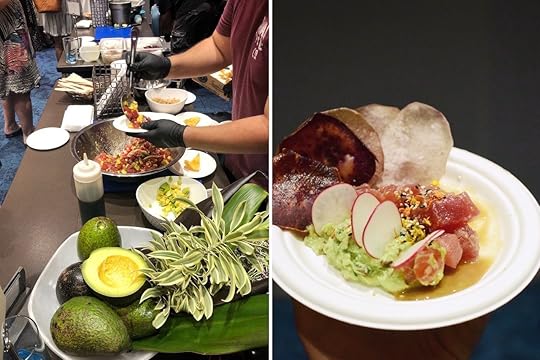
Photo: Nickolaus Hines
This long history and recent uptake by mainland chefs was on my mind when I came to Kauai for the poke festival.
Before Sam Choy took the stage at Koloa Landing for Kauai’s first poke festival, I stopped by the small parking lot designated for food trucks. I chose mahi-mahi tacos from Uncle Bobby’sf food truck. I briefly questioned my choice to load up on fish right before loading up on even more fish when the festival started.
Marie Henningsen, who runs Uncle Bobby’s with her husband Robert, moved to Kauai from Phoenix a year ago. They took a risk on spending a business day at Koloa Landing instead of staying at their regular stop with their regular customers, but it looked to be paying off early.
“Makes sense why it’d be here,” Henningsen told me while I waited on the tacos, “as this is the event place to be on this part of the island.”
Koloa Landing is where the island’s marathon ends, as well as where numerous fitness events are held. Today, however, was all about food.
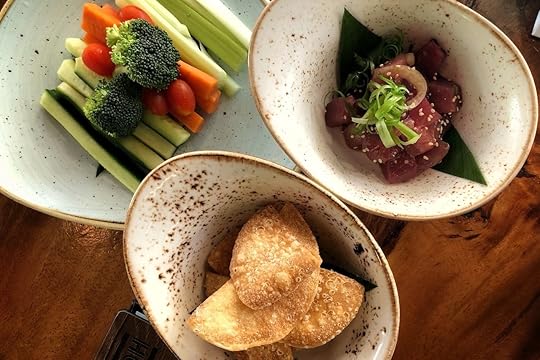
Photo: Nickolaus Hines
Sam Choy donned a headset microphone and took the stage early at the poke fest. Two sections of white chairs quickly filled up, as did the standing spaces behind and to the side of the chairs.
“We started about three months ago to get this off the ground,” Choy said, referring to the festival. “All to demonstrate what I’ve been making basically my whole life.”
As he spoke, he cut fresh-caught tuna into cubes and referred reverentially to the quality of Hawaii’s seafood. To his left, Kap Te’o-Tafiti, a cultural ambassador at the Polynesian Cultural Center, bantered back and forth with Choy while opening a coconut with a stick and his bare hands, then repeatedly squeezing the coconut meat with the water to create what has to be the freshest coconut milk I’ve ever seen.
You have to keep all the ingredients of an ocean-fresh poke in balance, Choy told the crowd as he sliced and chopped, but “you can poke anything you want.” Dishes evolve and change, and there’s no such thing as a static cuisine. It’s important to note who is getting credit as the dishes change, however. Any talented chef can make a riff off of poke that tastes good, but we can’t pretend they’re making something new. New trendy dishes stand on the shoulders of old cooking traditions — there would be no mainland poke craze without the people who have poked fish for hundreds of years.
Choy’s poke he made on stage took inspiration from a Samoan version of poke made with lime juice, and Te’o-Tafiti added (between labored breaths and coconut squeezes) that poke is oka in Samoan. Choy added salt to the cubes of tuna and stirred. He followed the salt with lime, olive oil, and cubed tomato, cucumber, and sweet onions. The color slowly changed as the fish was lightly cooked by the acid. Choy reached and grabbed a bite. “Oh man,” he exclaimed. He kept stirring, killing time before Te’o-Tafiti finished with the coconut milk.
“I’m cooking, and people ask, ‘why don’t you guys use gloves?’” Choy said as he added jalapeño. “Because we’re a real cooking show. These hands make real food.”
Te’o-Tafiti finished preparing the coconut milk and poured it over the fish while Choy kept stirring. Finally, he asked the festival’s celebrity guest, Kauai-raised professional surfer Sebastian Zietz, to try. It passed the Zietz taste test.
“We’ve got enough poke here for about 20 local people,” Choy said. He laughed a little, then added, “or about 80 tourists.”
A woman sitting next to me smiled along and said, half to herself and, it seemed, half to whoever was listening, “Well we live here part-time, so two servings right?”
Though simple, Choy’s stage-prepared poke represented the crowd of locals, mainlanders who live at Koloa Landing part-time, and tourists. There were the people like the woman next to me who lived part-time or were staying in the luxurious rooms at Koloa Landing, drawn away from the resort’s three pools by the famous chef. Then there were the locals who had stopped by out of curiosity or love for chef Choy. This poke, like the ones Choy puts on his restaurant menus on both Hawaii and the mainland, is for anyone who wants a taste of Hawaii.

Photo: Nickolaus Hines
Still, the outside influences on poke were present even at Choy’s first Kauai Poke Fest. As a member of the media, I was part of the panel that judged the competition portion of the festival, which pitted poke from more than 10 home and professional chefs against each other. One chef made shrimp poke with small dried shrimp on top, while another served his poke on a fried salmon skin chip. The media choice winner, Nancy Koumal, used a base of sockeye salmon, and the home chef winner, Sonny Thater, made a spicy tuna crunch poke. The winner among the professional chef class, Tyson Peterson, made what he called guacapoke served with radish slices and taro root chips.
“You’re judging something that dates back before Captain Cook,” Choy said. “You might not see that here, but it’s the foundation.”
After it was announced that Peterson won the professional class award, he told me he’s seen compressed watermelon, roasted beets, and beef pokes. Poke, he said, is a vehicle for creative chefs.
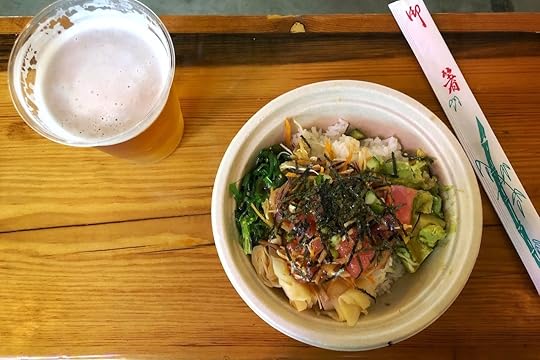
Photo: Nickolaus Hines
Back home in Brooklyn, I searched for a poke place that makes poke like those that I ate in Kauai. The first attempt was Wiki Wiki, which is located in a food hall in downtown Brooklyn. I ordered what was called the “classic Hawaiian shoyu tuna poke.” The bowl had cubes of tuna coated with shoyu (a type of Japanese soy sauce), seaweed salad, avocado, ginger, nori, and cucumber that sat on a big, fluffy bed of white rice. It was tasty — the tuna had a good texture and size with a balance of flavors other than one sinewy bite — and the main difference between it and the poke I had in Hawaii was that the serving size of the tuna was matched by every other ingredient and dwarfed by the amount of rice. It also cost $16 before factoring in tip and the 16-ounce draft Sapporo.
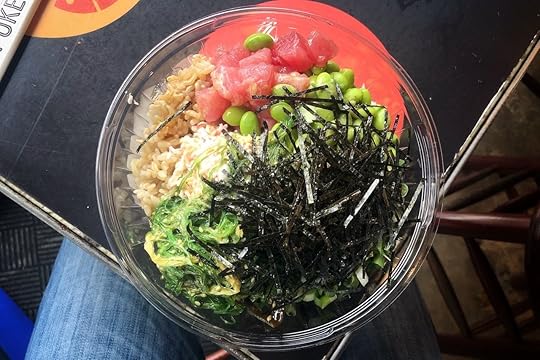
Photo: Nickolaus Hines
I tried another, the “poke bowl special,” at PokeBowl in the SoHo neighborhood of Manhattan. The woman in front of me in line asked if they have crab, and the chef plopped an ice cream scoop of finely chopped crab covered in a white sauce on top of her bowl. My $13 order was finished before I even made it to the register. It included two scoops of brown rice, scallions, edamame, seaweed salad, PokeBowl house sauce, shredded nori, tuna, and Kani salad (the crab and white sauce mixture). The only thing in the bowl that was cut into cubes was the tuna, again dwarfed by the servings of other ingredients.
It would be beyond naive to ask that poke be on the mainland what it is on the islands. Access to fish makes that impossible, as do the market demands of the people who are eating it. Recipes and dishes change as they move from place to place. What’s happened to poke outside of Hawaii, however, has been a rapid movement that feels like a rewrite of history and tradition.
In 2018, Aloha Poke Co. sent cease and desist letters to poke shops that used the word “aloha” to sell poke, claiming the Hawaiian word is protected by the company’s federal trademark. The company was widely called out for blatant cultural appropriation. Of course, not every mainland poke purveyor is trying to capitalize on Hawaiian culture while putting roadblocks in the way of actual Hawaiians. But, as I quickly saw, the fish-focused mentality of Hawaiian poke wasn’t there for the most part.
Still, says Roy Yamaguchi, there’s a net positive to poke’s popularity outside of the islands.
“The increased awareness of poke has created a deeper appreciation for Hawaiian food, as well as the Hawaiian culture,” says Roy Yamaguchi. “When people can learn about culture through food it often results in compassion, mutual understandings, and a connection to a place and its people. All the hype that poke has created in the world for Hawai‘i is good and will continue to be good.”
It’s important, Yamaguchi says, that restaurateurs and chefs keep seafood sustainability, fishermen’s livelihoods, and the health of the oceans in mind when serving poke. That’s perhaps never been more true than in this current era of exploding poke interest.

Photo: Nickolaus Hines
The band that kicked festivities off at Koloa Landing’s poke festival again thanked Choy for bringing a celebration of poke to Kauai.
There’s a fair argument to be made that where you eat something is just as important as what you eat, but the small serving of Choy’s poke that I squirreled away for myself was unlike any that I’ve had in New York. The poke was savory. The fresh coconut milk gave some oil and body while the lime added just the right amount of tart to, along with the jalapeño, balance it all out. The star, however, was the fish. While the ingredients aren’t the same as the first classic pokes, the dedication to quality fresh fish on the islands hasn’t wavered. I felt a tinge of jealousy that even in New York, America’s culinary capital, I couldn’t find poke that honored the ingredients as much as the ones here — even one made on a stage at a food festival. But then again, that tie to local ingredients is the whole point of Hawaiian poke, and that’s a flavor best tasted at the source. 

More like this: This rum distillery is helping Hawaii’s heirloom sugarcane thrive once again
The post In Kauai, poke is an ever-evolving dish unlike anything on mainland America appeared first on Matador Network.

Food truck cities
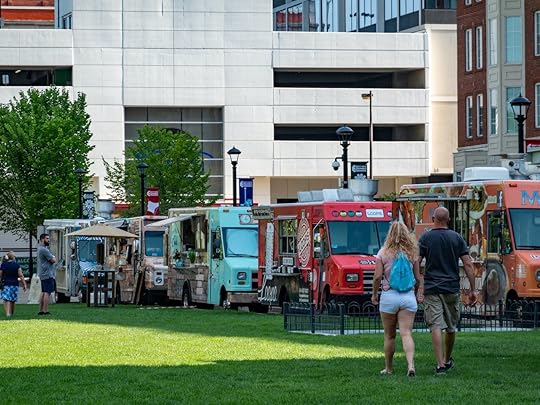
There’s just something about a meal prepared inside of a truck. Maybe it’s the efficiency of the experience, the perceived affordability, or just the sheer fun of strolling up to a colorful Mystery Machine clone and walking away with a handful of fish tacos. Whatever the reason, the love for food trucks and changing food service laws have led to an explosion in popularity all across the US.
Today, food truck festivals are worthy of a Google calendar alert, and the divine appearance of an ice cream sandwich truck in July will result in a line two blocks long. Gone are the days of food trucks as a novelty or solely a late-night drunk food option. These are the US cities with a food truck scene as delicious as it is unexpected.
Orlando, Florida

Photo: SMAC Food Truck/Facebook
Orlando is more known for its world-famous theme parks, but it’s also the “food truck capital” of the US. By some counts, there are more than 200 food trucks currently in operation in Orlando. While food trucks are pretty ubiquitous, you’ll find the greatest concentration downtown, specifically in the Milk District and Williamsburg. And if you just can’t decide, visit the Food Truck Bazaar in Windermere to sample several at once.
Orlando food trucks to try:
The Pastrami Project — Perfect for all the snowbirds out there, this truck serves up New York-style deli meat hand-cut right in front of you. New York classics like corned beef, pastrami, bagels, and lox, are of course on the menu.
SMAC Food Truck — The premier stop for mac and cheese in Orlando. Serving South Carolina-style mac and cheese, the SMAC truck offers the classic SMAC, SMAC with layers of bacon, lobster SMAC, pulled pork SMAC, and more.
Little Blue Donut Truck — Doughnuts aren’t just for bakeries. In Orlando, the best doughnuts come from this blue truck, which has a host of creative flavors from caramel apple crunch to snickerdoodle cookie.
Minneapolis, Minnesota

Photo: TOT BOSS/Facebook
Minneapolis often flies under the radar when it comes to its food truck scene. While Minneapolis might not be the country’s food truck capital, it’s far cheaper than in other cities, meaning you can try more of your favorite four-wheeled foods without breaking the bank. Although many of the trucks are seasonal (temperatures in Minneapolis can get pretty nippy in winter), there are still plenty of options to choose from that serve dishes inspired by cuisines from around the world.
Minneapolis food trucks to try:
Tot Boss — Whether it’s breakfast, lunch, or dinner, tater tots are always a good idea. Tot Boss incorporates tater tots into nachos, poutine, burritos, and other dishes.
Foxy Falafel — A place that’s famous around the city for its falafels made with local, organic ingredients, and a variety of bowl options.
R Taco — You might be far from SoCal, but you’re not far from a good taco. R Taco is one of Minneapolis’ favorite Tex-Mex spots, as it can always be counted on to warm your stomach even in the frigid winter temperatures.
Indianapolis, Indiana

Photo: Brozinni Pizzeria/Facebook
Indianapolis might not be at the top of your list of cities to visit for culinary delights, but it should be. It’s listed by CityLab as the fifth-most food-truck-friendly city in the country due to its laws that benefit small businesses, and it certainly lives up to the ranking. From creative salads to jerk chicken, pizza, and cupcakes, the Indy food truck scene has the same diversity you’d expect in New York City, Los Angeles, and San Francisco.
Indianapolis food trucks to try:
Brozinni — This pizza truck is basically a full-fledged restaurant on wheels. It’s equipped with a full stainless steel pizza oven and kitchen, and frequently caters events and parties. New Yorkers may take issue with this, but the truck promises a crust that tastes just like the ones in the Big Apple, as well as a range of other Italian snacks.
Caveman Truck — The longest-running paleo food truck, in operation since 2012, Caveman Truck believes that eating “like a caveman” can produce astounding nutritional results. Serving local fruits, vegetables, and pasture-raised proteins, the truck is perfect for those on a paleo diet or looking to take the plunge for the first time.
Da Blue Lagoon — Indianapolis isn’t exactly the Kingston of the Midwest, so you might be surprised to find some pretty delicious Jamaican food here. Using family recipes from Jamaica, this truck brings the authentic jerk flavor of the Caribbean to the streets of Indianapolis, particularly with the signature Jamaican jerk patties.
Houston, Texas

Photo: Bernie’s Burger Bus/Facebook
Everyone knows Austin as Texas’ “weird” city, but Houston is quickly becoming the state’s city of food trucks. One of the most culturally rich cities in Texas, Houston is home to a diverse restaurant scene, which is also reflected in the abundance of food truck options. From classic southern burgers to Vietnamese fare, Houston’s food truck scene has it all.
Houston food trucks to try:
Bernie’s Burger Bus — This is the happiest you’ll ever be to see a school bus. Bernie’s is a Houston favorite for its classic approach to homemade burgers and condiments. Served out of a big yellow school bus turned food truck, Bernie’s Burgers prides itself on making fresh burgers daily with no preservatives.
Nom Mi Street — Houston is a hub for some of the best Vietnamese food in the country, and the place of origin for modern classics like Viet-Cajun crawfish. A Houston staple since 2012, Nom Mi Street serves locally famous Vietnamese sandwiches, tacos, and quesadillas. The truck regularly appears at the City Hall Farmers Market on Wednesdays, so keep an eye out.
Cousins Maine Lobster — It may feel unnatural to eat lobster anywhere outside New England, but the Cousins Maine Lobster truck deserves a pass. With funding from Shark Tank, this truck brings Maine lobster rolls, tacos, and quesadillas to the streets of Houston. Cousins Maine Lobster is one of many food trucks in Houston’s Museum District and Hermann Park, which has become a thriving area for both culture and street food.
Raleigh, North Carolina
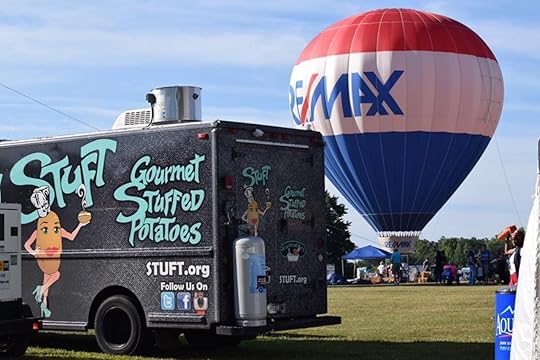
Photo: STUFT/Facebook
Raleigh’s food truck scene is a blend of Northern and Southern cuisine, and many trucks do a modern twist on traditional Southern recipes. It’s not unheard of for ideas created in food truck kitchens to find popularity in restaurants across the city, showing how Raleigh’s food truck and restaurant communities are truly interlinked.
Raleigh food trucks to try:
Stuft — If you’re a potato-lover, look no further. Stuft serves gourmet baked potatoes in more varieties than you can imagine. That means baked potatoes stuffed with buffalo chicken, creamed spinach, garlic roasted veggies, barbecue chicken, and more.
CockADoodleMoo — This husband-and-wife-operated truck serves up sandwiches made with local, all natural ingredients, with a wide range of traditionally Southern menu items. The brisket and short rib sandwiches are crowd favorites. Check out the truck’s schedule to see when and where it will be roaming the city.
Not Just Icing — True to its name, Not Just Icing provides some of the area’s most delicious cupcakes and cookie dough. They use real fruit instead of flavored extracts, and the cookie doughs are made with heated flower and without eggs.
Columbus, Ohio
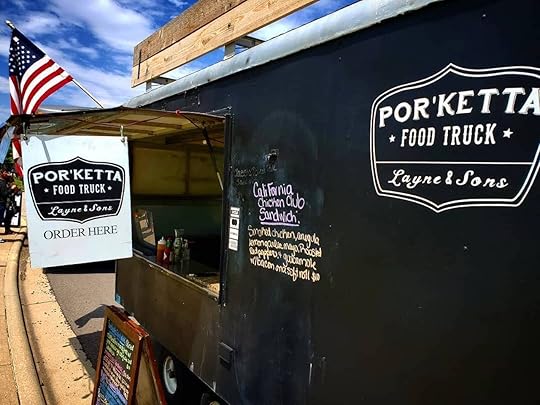
Photo: Por’Ketta/Facebook
Everyone knows about Columbus’ thriving brewery scene, and it’s only natural that a solid food truck culture would follow. The city has some of the best food trucks in the Midwest that are operated by local families and chefs passionate about bringing their unique brand of culinary flair to the streets of Columbus.
Columbus food trucks to try:
Por’Ketta — This truck specializes in comfort food, meaning you’ll probably be full for the next three days. But that’s a good thing. Its rotisserie pulled chicken sandwich is a thing of legend in Columbus, and most ingredients are sourced from local farms. The Pork Sundae is another fan favorite, stacked with slow braised pulled pork, barbecue sauce, chili lime crema, onions, cherry peppers, corn bread, and potato salad.
Mya’s Fried Chicken This fried chicken truck is locally famous for its buttermilk brined chicken, homestyle biscuits, and chicken and waffles.
Buckeye Donuts — A Columbus institution since 1969, Buckeye started as a doughnut shop on the Ohio State campus. The food truck’s long history of doughnuts is supplemented by heartier meals like chicken and waffles sandwiches, tater tots, and gyros.
Philadelphia, Pennsylvania

Photo: SPOT Gourmet Burgers, Steaks, & Pork/Facebook
Philadelphia might be known for its cheesesteaks, but with more than 150 food trucks roaming the city during the warmer months, cheesesteak is only the beginning. The areas near UPenn, Drexel, and Temple are sure bets for finding an abundance of food trucks that cater to students, while those in Center City serve the professional crowd.
Philadelphia food trucks to try:
Spot Burgers — You’re in Philadelphia and want to try a whole range of foods (not just cheesesteak), but let’s face it. You’re probably looking for the cheesesteak first. The Spot Burgers truck has traditional cheesesteaks, chicken cheesesteaks, and buffalo chicken cheesesteak, and you can customize your sandwich with a variety of cheeses, toppings, and condiments, including the signature “Spot Sauce.”
Foolish Waffles — Waffles might sound like breakfast, but in Philadelphia, they’re part of any balanced meal. Foolish Waffles serves waffles with eggs and bacon, as well as fried chicken, banh mi, and pretty much any other creative accompaniment you can imagine.
Sugar Philly — There’s always room for dessert. Sugar Philly combines French culinary tradition with a Philly way of life, and serves up accessible versions of gourmet desserts. The salted caramel macarons are among the most popular items, along with the crème brulée and crème fraîche cheesecake.


More like this: Our favorite food cities of the past decade
The post 7 unexpected food truck cities in the US to pay attention to appeared first on Matador Network.

7 foodie experiences in Ft. Myers
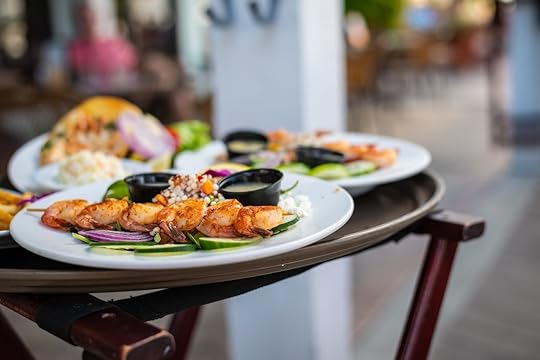
Most places in the U.S. aren’t as lucky as Southwest Florida. Miles of beaches, the warm waters of the Gulf of Mexico, both nature and nightlife, and access to super-fresh cuisine all year long? You can practically hear the rest of the country sighing.
But it’s that last one that causes foodies to flock here in droves, and not just in winter. With a culinary history tying together fishermen, farmers, and plenty of warm days, The Beaches of Fort Myers & Sanibel hits the cuisine jackpot — come here, and you’ll strike it rich, too. Let the seven tasty experiences below serve as proof.
1. Island hopping to lunch and dinner
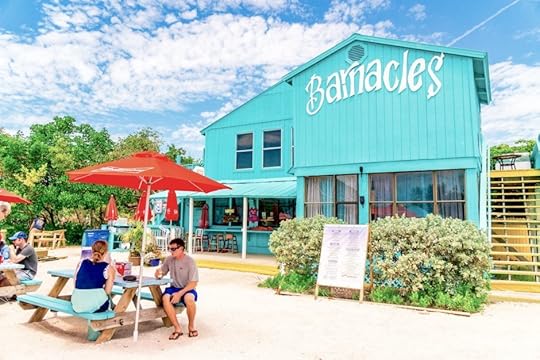
Photo: The Beaches of Fort Myers & Sanibel
Cut the motor and glide in to the docks of North Captiva Island. This four-mile-long barrier island is a tranquil reprieve from the mainland — it’s only accessible by boat or ferry, has fewer than 400 houses, and “traffic jams” are the occasional meeting of golf carts. Once you’re done exploring this slice of Old Florida, settle down to a basket of shrimp and fries from a colorful fish shack, and watch the boats float to and fro.
Next up, head north for the pristine beaches of Cayo Costa State Park. Then, when you’re feeling famished from all your sandbar (and seashell!) explorations, cruise over to another island, like Pine, Sanibel, or Captiva, for a sunset dinner (there are plenty of westward-facing options on all three). You’ll feel like part of a secret club — one filled with salty dockmasters, friendly pontoon boaters, and sleek yachts — dedicated to exploring the culinary vibes of the islands.
Stay: The former fisherman’s haunt of Cabbage Key is a 100-acre island in Pine Island Sound, and the Cabbage Key Inn & Cottages — literally the places to stay on the island — speak to that history with authentic, island-style charm. Some of the cottages have their own private docks, not surprising considering this island, too, is inaccessible by car. At night, check out the inn’s lively restaurant and bar decorated with old photographs and thousands of dollar bills.
2. Pink Gold shrimp
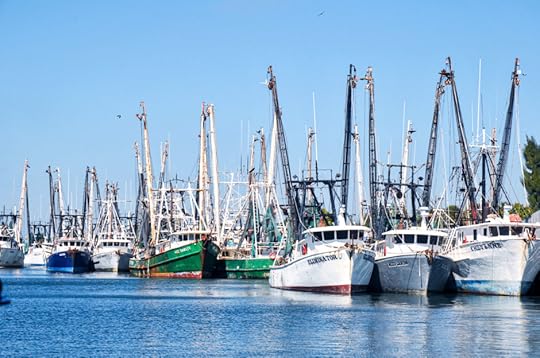
Photo: The Beaches of Fort Myers & Sanibel
Just 14 miles off the coast of Southwest Florida are shrimp beds that stretch from Sanibel Island down to the Florida Keys. On San Carlos Island, between Fort Myers Beach and the mainland, shrimpers have been docking for years — today, they make up the largest commercial fishing fleet in the Gulf of Mexico. Their catch: Florida Pink Gold, textured but tender and slightly sweet, leagues away from what your local grocery store offers in the frozen section. It’s in a class all its own.
Three-hour tours covering the ins and outs of the San Carlos Island Commercial Fishing Fleet show visitors the process, from sewing the nets to unloading the boats to building trawl doors. You could also just skip all the “how it’s done” and go straight to the “how it tastes” by visiting one of the many markets or restaurants that dot the waterfront and serve up super-fresh Pink Gold.
Stay: DiamondHead Beach Resort is smack dab in the middle of all the shrimp action. It’s located on Fort Myers Beach, less than two miles from San Carlos Island. The family-friendly resort has suites with kitchenettes and screened-in balconies, a pool, and hot tubs. For dining, there’s Cōste, serving island cuisine for breakfast and dinner. And don’t miss the beach bar, where you can go barefoot on the sand while savoring a shrimp taco.
3. Island — and off-island — brews
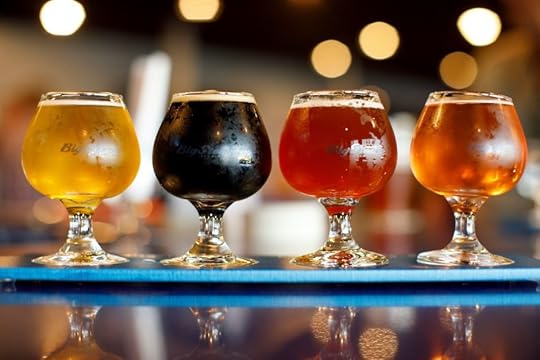
Photo: The Beaches of Fort Myers & Sanibel
Citrus-y lagers, chocolate-peanut porters, and mango-habanero IPAs. The Beaches of Fort Myers & Sanibel doubles down on “do-it-yourself” and “do-it-local” with twelve breweries in the county — easily enough to create your own tasting itinerary or go on a brewery-hopping tour. There are beer halls, tap rooms, and open-air bars serving up everything from tiny tasters to takeaway growlers that double as mementos.
Stay: Pink Shell Beach Resort & Marina, at the northern end of Fort Myers Beach, is the type of resort you never need to leave — apart from the fact that the breweries of Fort Myers are just a short drive away on the mainland. When you’re done touring tasting rooms, the resort has a wide, private beach with sunbeds and umbrellas, a network of pools, a spa, marina, and restaurants to come home to.
4. Cocktails on the shore…
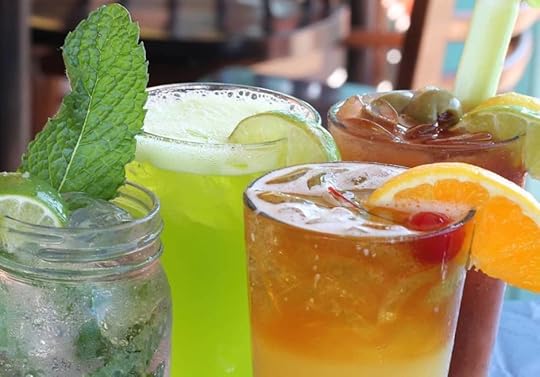
Photo: The Beaches of Fort Myers & Sanibel
Toes in the sand, cocktail in hand — this is when “being on vacation” finally sinks in. With the right open-air spot (and the right beverage), you could stay all day, no change of clothes or equipment required, until the sky turns from bright blue to tangerine, and a green flash bursts across the sky.
Here in Southwest Florida, most stretches of beach aren’t far from something coconutty or something hoppy, something blended or something salty, something to suit every type of mood and personality. There are the classic watering holes set underneath palm trees and surrounded by sea oats. There are party spots with Rum Runner specials and water-balloon-throwing contests. There are casual hangouts where you can play a round of cornhole, beer in non-tossing hand. And, best of all, there are secluded oases where no one will ever find you.
Stay: With five options shared between two of their properties on Sanibel and Captiva Islands, Sanibel Captiva Beach Resorts has a restaurant to suit every taste. (The Oasis Pool Bar at ’Tween Waters is a fan favorite when it comes to adult beverages.) Bonus: Book a room here and you’ll have everything you need for the perfect Southwest Florida vacation at your fingertips.
5. …and dining on the waterfront

Photo: The Beaches of Fort Myers & Sanibel
You know that moment when you’re standing in front of the ocean and you can feel your mind shift? That’s an actual scientific thing. Look at a body of water for a few minutes, and your brain waves will start to resemble those of someone in a meditative state.
On The Beaches of Fort Myers & Sanibel, there’s no need to interrupt the feel-goods at meal time. Everywhere you look there’s a meal-by-the-water situation: sleek wood-and-glass restaurants facing the Gulf, bustling dockside seafood shacks with live music, and beachside burger joints where everyone on the island goes to watch the sunset.
Stay: ’Tween Waters Island Resort & Spa spans from the quiet bayside to the Gulfside on Captiva Island. There are seaview guestrooms and suites, pools, a canoe and kayak club, a spa, and two restaurants. Old Captiva House at ’Tween Waters has fantastic views, with wraparound windows that open onto the Gulf of Mexico. Not to mention, it’s on the National Register of Historic Places!
6. Florida farm fresh
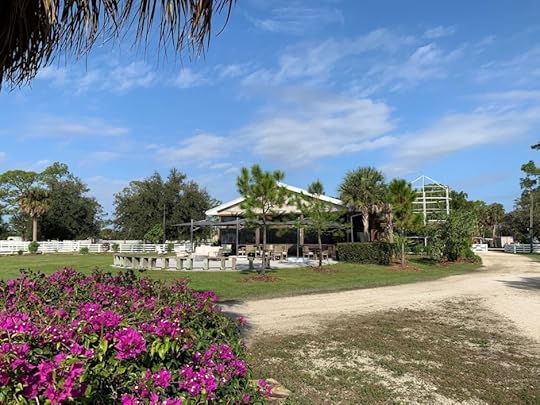
Photo: The Beaches of Fort Myers & Sanibel
With 200+ days of sunshine, warm Gulf of Mexico waters, and temps that never freeze, Florida was doing farm-to-table food before it was cool. Heck, before it even had a name. But more importantly, it’s not just about ultra-fresh, local food — farmers here also pride themselves on community-driven, sustainable practices.
If you’re in the Fort Myers area, go straight to the source and visit the farms themselves, which makes for a true experience. Take Rosy Tomorrows Heritage Farm, for example, which has a sleek restaurant (reservations required) serving meat from pasture-raised pigs and heritage-breed chickens. After your meal, you’ll be able to explore the farm and stock up on local produce and other items at the farm shop.
Visit: Another requisite stop on any Florida farm-fresh tour is Harvest & Wisdom at Shangri-La Springs, a restaurant where meal ingredients are sourced ultra-locally. There’s an onsite no-till garden, meat is raised at nearby Circle C Farm, and the seafood is certified organic. Follow your meal with a tour of the historic Shangri-La Springs grounds, or book a treatment at the full-service organic spa.
7. Hook it and cook it!
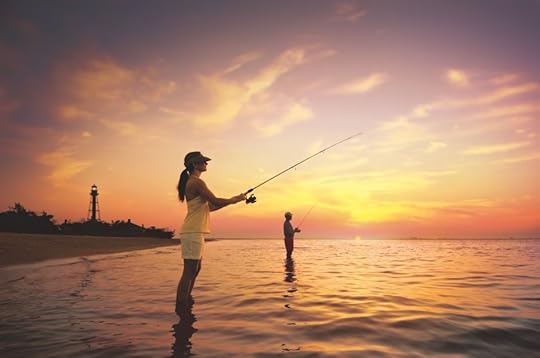
Photo: The Beaches of Fort Myers & Sanibel
You catch it, they’ll cook it. Spend a day fishing at Blind Pass or further offshore on a charter boat, then bring in whatever you catch to a local restaurant. They’ll grill it and serve it to you with all the fixings. If you’ve never walked into a classy restaurant with a fish in your hand, now’s the time. Note: You’re most likely to catch mild and flaky grouper or snapper if you’re offshore, or the flavorful snook if you’re fishing from the beach.
Stay: Tarpon Lodge & Restaurant is a historic hideaway on Pine Island with a lodge, cottages, and restaurant that opens onto a deck and grassy lawn facing the sound. This former fishing lodge has a cozy vibe, with wood floors and a brick fireplace, and if you bring in your catch-of-the-day cleaned and filleted, they’ll cook it up for you. And remember: It’s not just treating yourself to a nice dinner — here, it’s taking part in Old Florida tradition. 
The post 7 food and drink experiences to have on The Beaches of Fort Myers & Sanibel appeared first on Matador Network.

Utah bans LGBTQ conversion therapy

Utah is known for having laws more conservative than most of the United States, but the state has just become the latest to ban the controversial conversion therapy practice for LGBTQ minors. The practice, which has been widely discredited by experts, is aimed at changing a person’s sexual orientation or gender identity.
The ban, however, does not prevent clergy, religious counselors, parents, or grandparents from employing similar conversion techniques, as long as they aren’t acting as psychologists.
NPR reported that suicide rates among LGBTQ youth triple when parents, psychologists, and religious leaders attempt to change their sexual orientation.
Utah is the 19th state to ban conversion therapy for minors, though it’s the only state where Republicans control the governorship and both state legislature houses to do so. 

More like this: The 10 best LGBTQ-friendly small towns in the US
The post Utah is the latest state to ban LGBTQ conversion therapy appeared first on Matador Network.

Does vitamin C work to prevent cold

The guy next to me seems enamored with his effervesce. He’s dropping some high-dose vitamin C powder into a cup of water he requested from the flight attendant, and looks to be enjoying it like it was a rare, 25-year-old Scotch.
“I take this every flight,” he says to the no people who asked him. “That’s my secret. Hundred-thousand miles a year and I never get sick. I swear by this stuff.”
I asked him what he did for a living, and he was not, in fact, a dietitian or a medical professional. He was just a guy in a field that required a lot of travel, which got me wondering: Was there anything in that little fizzy cup that was proven to work better? Or are vitamin C supplements a whole lot of anecdotal evidence and placebo with a nice marketing package attached?
Why people think vitamin C prevents colds
“Most folks believe that it’s useful to take vitamin C when preventing or fighting a cold,” says Kimberly Gomer, the director of nutrition at Pritikin Longevity Center + Spa in Miami. “This misinformation stems from the famous research from Linus Pauling who claimed years ago that large doses of vitamin C could prevent a cold. But that hasn’t been supported in the research.”
Never heard of Linus Pauling? He’s a chemist and the only person to win two unshared Nobel Prizes, but his lasting legacy is probably his assertions that vitamin C could not only eradicate the common cold, but can also help you live longer and prevent almost all diseases.
Unlike the work he won Nobel Prizes for, his vitamin C claims were largely anecdotal. But because they came from such a credible source, people came to believe vitamin C was a cure for the common cold. Hundreds of vitamin C products flooded the market, and despite mounds of evidence to the contrary, plenty of people like my airplane seatmate still seem to think it works.
“It’s not going to prevent a common cold, that’s pretty much a myth,” says registered dietitian Jessi Morris.
She says “pretty much” because a 2013 study from the Cochrane Database of Systematic Reviews examined 29 different vitamin C trials, and found that ultra-active people like marathon runners, alpine skiers, and military special forces saw a 50 percent reduction in their risk of getting a cold when taking 200 milligrams of daily vitamin C.
But that same study found no benefit at all for people who weren’t burning upward of 10,000 calories a day. So that preflight supplement likely won’t do you much preventative good, even if you did knock out 30 good minutes on the elliptical.
Part of why ultra-active people might see a better benefit from vitamin C is because of how it works. Vitamin C is an antioxidant, which helps the body fight free radicals. These are very healthy and impressive-sounding terms that look sexy on a vitamin bottle, but what do they actually mean?
Technically speaking, free radicals are molecules that have an unpaired electron. These radicals are highly reactive, and can go after DNA, proteins, carbohydrates, and lipids in the human body. This, in turn, can lead to cell damage. When free radicals break in and steal electrons, they leave all kinds of damage to your body, from diseases to colds to genetic mutations. Free radicals are bad dudes, but instead of punishing them, vitamin C instead donates an electron to them. This way they are happy, and don’t go around pillaging electrons from healthy cells. Vitamin C isn’t so much fighting free radicals as it is acting as a charitable organization for disadvantaged atoms.
This act of helping free radicals gain electrons is why vitamin C is helpful for people who break up oxygen in large amounts — runners, skiers, secret agents — but not as much for couch surfers.
Vitamin C can reduce the time it takes to heal

Photo: Orawan Pattarawimonchai/Shutterstock
Because vitamin C helps protect healthy cells, it can still be useful in reducing the time you’re sick and alleviating your symptoms.
“We need lymphocytes, or T cells, and vitamin C helps with that,” says Marina Yuabova, assistant professor at City University of New York and founder of Integrated Wellness NY. “Vitamin C helps white blood cells work more efficiently by fighting damage from free radicals. Then it also helps in the production of collagen, and for people who don’t heal very well they can heal faster because of the collagen buildup.”
The data supports her, too. That same study that found vitamin C wasn’t too effective in preventing colds also found 200 milligrams a day reduces the duration of cold symptoms by 8 percent in adults, and by 14 percent in children.
Morris echoes the 200 milligram per day suggestion, since the water-soluble vitamin is mostly excreted in the urine past that point. Though one Finnish study found reductions of 10 to 20 percent in cold duration in doses between 3,000 to 8,000 milligrams per day. Yet doses that high can also cause diarrhea, nausea, and other things you don’t want to happen while you’re stuck on a plane.
But if you want those vitamin C supplements to do anything, Morris says the most important thing is to take them religiously.
“You can’t take it at the onset of a cold, and then have a reduced duration of symptoms,” she says. “It’s not like echinacea or high-dose garlic or elderberry. You need to be taking vitamin C regularly.”
And while supplements can be useful in doing that, Pritikin Longevity Center’s Gomer says your best bet is still probably getting a lot of it in your diet.
“It’s always better to get your Vitamin C from food, because along with the C comes other important nutrients such as potassium and fiber,” Gomer says. “Another reason to eat all those fruits and veggies. Taking a supplement is not the best way.”
So while the guy next to me may not have been doing any harm in taking his traditional packet of fizzy vitamins, they were at best only part of the reason he stayed so healthy. Vitamin C may have a lot of health benefits, but curing the common cold is not one of them. You may just get more benefits by making your preflight meal a fruit salad. 

More like this: Why you get dehydrated on a flight and how to prevent it
The post Are your preflight vitamin C supplements actually doing anything? appeared first on Matador Network.

Matador Network's Blog
- Matador Network's profile
- 6 followers



